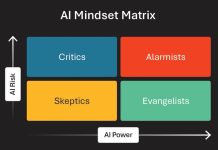Sales leaders are under pressure to deliver higher revenue with leaner teams. Enablement leaders are expected to scale learning across dispersed sellers. AI promises help on both fronts. But many organizations are discovering the hard way that AI tools deployed in isolation create inefficiencies, erode trust and fail to deliver measurable improvements.
As Chris Jackson, distinguished architect at Cisco, put it in the recent session at the Gartner CSO and Sales Leader Conference, “An island of AI is useless. It has to be part of the system, part of the workflow.”
This article explores why disconnected AI tools underperform and what organizations must do to integrate them effectively.
Symptoms of the ‘AI Island’ Problem
Despite rapid adoption, most AI initiatives in sales enablement and coaching fail to scale. Why? Because most tools operate in silos:
- A call analysis tool flags filler words but misses the nuance of a sales conversation.
- A copilot suggests next steps without understanding what coaching actually means.
- A learning platform recommends generic content unlinked to behavior.
The result: inconsistent guidance, duplicated effort and reduced seller confidence in both tools and training.
A tool is not a strategy. And tools that don’t share data or reinforce a shared methodology generate more friction than value.
A Salesforce report indicates that sales teams use an average of 10 tools to close deals, leading to a disjointed patchwork of data and dashboards. This complexity causes two-thirds of sellers to feel overwhelmed.
This fragmentation reflects the reality of how AI has developed – with most enterprises embracing general tools such as Microsoft Copilot, the embedded AI within their existing platforms, and some new point solutions such as platforms for AI role plays. Sellers now face a cluttered ecosystem of dashboards and copilots, unsure which one to trust.
This is unsustainable from a human perspective, with sellers already under a high cognitive load. Being asked to navigate 12 conflicting AI tools based on siloed data increases frustration, not fluency.
Fragmented AI creates friction across coaching, content and conversion, resulting in sellers disengaging, managers losing visibility and strategic alignment breaking down. We need a strategy for sales AI.
Focus on Insight, Influence and Trust
A major Imparta research study into successful selling resulted in the 3D Advantage framework, which sets out three dimensions that sellers must master: Insight, Influence and Trust. It turns out that the same three dimensions are applicable to AI. Effective AI needs to:
Deliver Relevant Insight
AI should deliver insight to sellers around the company’s products, services, policies and processes. It can also bring an evolving insight into their own strengths and weaknesses, relative to the requirements of their current role – and their next one. Finally, AI should bring deep insight into selling best practices, yet generic AI is actually poor at selling.
Improving AI’s performance on the insight dimension involves connecting it to a single source of truth of company data, a repository of information about the sellers themselves, and to a sophisticated retrieval-augmented generation (RAG) database of sales research and best practices. It also involves AI design that can interpret what each individual needs at any given time.
Influence Seller Behavior
Most AI delivers knowledge and advice in bullet point form. Yet as any expert in coaching will tell you, this is not an effective way to get people to change their behavior. In a sales enablement context, it can also lead to laziness and skills atrophy across your sales team.
Instead, AI in a sales enablement capacity needs to be trained and prompted to coach – and to coach properly, in an empowering way, not just to deliver feedback and training. The different AI use cases, from call assessment to simulations and role plays to nudge questions and dashboards, all need to be integrated around a change process designed with human psychology in mind. And AI agents need to work hand in hand with human change agents, including managers, coaches, champions and even trainers.
Build and Maintain Trust
Trust develops when AI is consistent and reliable, knows the user well, is focused on their success, and under control. Sales AI needs to be available in a consistent format across the tech stack. It needs to learn about the user and their needs, and to evolve with them.
For scalable solutions, the AI also needs a closed-loop measurement approach that tracks seller actions prompted by AI insights, and measures the impact of these actions. Ideally, it will also stay aware of changes in the market and allow continuous refinement of skill priorities based on that understanding. These analytics also extend trust up the management chain to sales enablement, leadership and even the IT and InfoSec teams at the company.
For Enablement Leaders: Build Learning Systems that Work in Context
Enablement teams are often early adopters of AI, but rarely have the capacity to connect different instances together. This leads to overlapping tools, conflicting prompts and low adoption.
To scale learning that sticks, enablement must move from deployment to orchestration:
- Embed methodology-aligned coaching into CRM and sales workflows.
- Deliver training and reinforcement in the flow of work.
- Trigger coaching based on seller actions and performance data.
Cameron Tanner, senior director of global sales enablement and acceleration at Cisco, summarized the problem: “Even the most advanced sellers don’t want 12 copilots. They want seamless, in-context support.”
At Imparta our agentic infrastructure supports a future-proof solution that includes:
- A consistent interface embedded in the flow of work across the tech stack, using a combination of text, voice and video avatars. This can be done within each platform or using tools that sit on top of them.
- An orchestrator that is the primary manager of the user relationship
- A multi-vendor set of headless agents that are called and controlled by the orchestrator, allowing access to the “best of the best” tool for any task across all parts of the sales tech stack
This approach ensures that sales professionals receive tailored guidance and support directly in their workflow without disrupting their usual processes, and it ties together AI support from multiple vendors and platforms into a single solution.
Five Ways to Shift from Tools to Systems
Moving from isolated AI features to a unified enablement system requires more than technical integration; it demands strategic coordination across data, workflows, methodology and measurement.
These five priorities provide a practical blueprint for embedding AI in ways that drive consistency, adoption, and commercial results.
1. Shared data foundation
Connect all AI tools to single, trusted sources of information around sales best practices, user profiles and company data.
2. Methodology alignment
Ensure all AI-generated prompts and resources reinforce your core sales methodology and connect to your training. It makes no sense to disconnect sales enablement and skill building.
3. Influence, Not Just Insight
Go beyond bullet points to use the single approach that research shows is most effective in improving sales performance: question-based, empowering coaching.
4. Orchestration Layer and Headless Agents
Create a single point of entry across your sales tech stack, powered by an orchestrator that in turn calls a multi-vendor set of headless agents.
5. Closed-Loop Measurement
Track which insights are acted on, how sellers respond and what business impact follows.
Imparta has been named a Leader in The Forrester Wave: Sales Training Services, Q1 2025, recognized for helping global organizations embed behavior change at scale. Our i-Coach AI platform is built on three decades of sales research and best practice. We bring together a deep understanding of technology, methodology and human change processes to deliver impact at scale.




